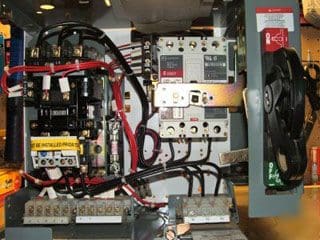
Electric motor protection device depends on the accurate and correct selection of overload(s), fuses and/or circuit breakers. Over the years the protective devices have been selected according to the applicable code requirements with only minimal nuisance tripping. However, in recent years, the problem of nuisance tripping due to the high motor inrush currents that occur during motor starting has gained increased attention.
In order to avoid the problem of nuisance tripping, application engineers have been forced to either set the HMCP magnetic circuit breaker above code requirements or take a step backward and exchange the HMCP circuit breaker for an inverse time circuit breaker. Both scenarios have the disadvantage of sacrificing the close coordination protection for which HMCPs were initially designed.
The National Electric Code (NEC) was changed slightly in 1996 to address this problem. The problem stems from the fact that the NEC allows certain settings for HMCPs (currently 800% of full load current, 1100% for design E motors) based on the motor’s locked rotor current (LRC), which is generally 600% to 700% of full load current (FLC). However, with high efficiency motors the inrush current may exceed the 800% of FLC.
Also, the application voltage may be over the nominal by 3 to 5%.
These factors will cause the initial inrush current to be much higher than usual. Additionally, one other phenomenon that will exacerbate the situation is that the initial peak inrush current will not be symmetrical.
Why is Inrush Current So Much Higher Than LRC?
LRC is a steady state current. That is, it remains constant so long as the rotor is not moving. Motors, however, are highly inductive loads. Like all inductive loads they generate an initial transient (short lived) response which causes the load to draw more current.
The steady state LRC is symmetrical when voltage is near zero. The initial transient response raises the LRC curve so that it is no longer symmetrical – thus giving it the name “asymmetrical offset”. This asymmetrical offset usually lasts only a few cycles as the current settles to a normal steady state LRC, which dies off as the motor begins to rotate (refer to Figure 1).

The asymmetrical offset is dependent mainly upon at which point on the voltage wave the circuit is energized. If the circuit is energized at a voltage maximum, there is no asymmetrical offset and the inrush current is essentially the LRC for that current phase.
However, if the circuit is energized when the voltage is zero the initial inrush current is made completely asymmetrical, that is, shifted from the nominal current axis (refer to Figure 2).
This makes the inrush current greater than the LRC for that current phase.
Also, in a three phase system, the odds of one of the phases being at or near voltage zero when starting a motor is very high. This explains the source of nuisance tripping. Considering the actual asymmetrical inrush current could be, according to NEMA manufacturers, as much as two times the LRC. A HMCP circuit breaker (that is set based on the LRC) and is used with a high efficiency motor will experience nuisance tripping during energizing.
Thus, the inrush could be 18 times the FLC – much higher than the 13 times FLC that the HMCP circuit breaker may be set to by the NEC.

So What Do I Do About It?
If your motor control center equipment has already been installed, one may have few options:
- Choose a HMCP circuit breaker with a higher instantaneous trip range.
- Substitute a thermal magnetic circuit breaker with a higher instantaneous trip range.
If you are still in the planning stages, making a few additional considerations now can save you a lot of headaches down the road.
- Get a complete set of specifications from the motor manufacturer and be sure to request data on the actual maximum inrush current along with the FLC and/or LRC ratio data.
- Specify motors with inrush to FLC ratios that would prevent you from violating the NEC.
- Make certain the motor is built to NEMA standards.
- Do not exceed the nominal voltage by more than 2 or 3%.
- Encourage the National Fire Protection Association (NFPA) to further address this issue in future editions of the NEC.
SOURCE: Rockwell Automation | Allen-Bredley – High Efficiency Motor Protection











Hi , Many thanks.
Great paper published by Rockwell Automation.